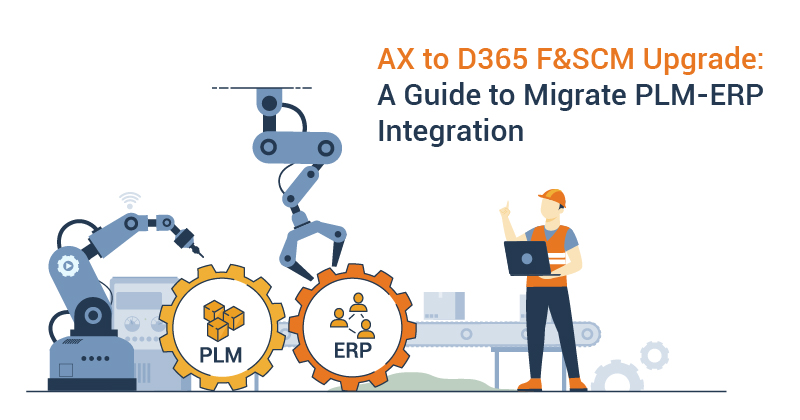Any manufacturing business knows how vital it is to have a proper system for controlling product data. However, if you are using Dynamics AX, you have limited ability to control and manage product data.
An upgrade from Dynamics AX to Dynamics 365 solves this issue as the latter offers an advanced change management functionality, easing product data management.
With 18+ years of experience offering solutions on Dynamics 365 to manufacturers, we have often been asked, "Should my manufacturing business migrate from Dynamics AX to Dynamics 365"?
The short answer is Yes. And you must do it now.
This article will help you understand the key benefits of migrating from Dynamics AX to Dynamics 365 Finance and Supply Chain Management (F&SCM) for a smoother PLM-ERP integration.
Why should manufacturers switch from Dynamics AX to Dynamics 365 F&SCM?
Migrating from Dynamics AX to Dynamics 365 Finance and Supply Chain Management can benefit manufacturing companies seeking to integrate PLM and ERP systems.
Here are the top 9 reasons you should consider migrating from Dynamics AX to F&SCM:
1. Quick scalability
Dynamics 365 F&SCM is built on a cloud-native architecture, allowing manufacturing companies to scale their operations seamlessly. As business needs evolve, you can easily adapt to changing requirements, whether it’s adding more users, expanding into new markets, or accommodating increased data volume.
Dynamics 365 F&SCM can support a growing business as you can scale quickly using the monthly subscription model, which allows you to buy what you need. This scalability reduces the need for heavy upfront investments in hardware and IT infrastructure. When looking to integrate your PLM and ERP, it is best to select an integration that automates the import of large data volumes coming from the PLM.
2. Enhanced functionality
Dynamics 365 F&SCM offers a broader range of features compared to Dynamics AX. It encompasses finance, manufacturing, supply chain management, sales, customer service, and more, in a unified solution. This integration means as a manufacturer, you can manage your entire business cycle within a single platform, eliminating the need for multiple disparate systems and improving data quality and consistency.
Having an ERP system based on the latest technology in place makes the integration process with other PLM systems more productive, as your Dynamics 365 F&SCM ERP is enriched with the latest functionality.
3. Stay on the updated version
Microsoft has officially ended its mainstream support for Dynamics AX 2009/2012. With no active support, you cannot access any functional enhancements or security hotfixes Microsoft provides. In contrast, Dynamics 365 F&SCM is maintained according to the Microsoft update policy, guaranteeing you have the latest version of the ERP.
While you may not find the need to migrate immediately, you should begin upgrading to the latest version of the ERP (Dynamics 365 F&SCM) to maximize its potential with the latest features available on the cloud. This reduces your company's server care costs, eliminates investment in servers, and reduces IT staff hours toward ERP maintenance.
4. Efficient change management
In Dynamics AX, you have limited engineering change functionality to manage and control product data. However, Dynamics 365 F&SCM hosts the 'Engineering Change Management' (ECM) module that controls and manages product versions and releases. With ECM, products in Dynamics 365 can have specific versions with more engineering-related information, such as drawings, product status, route information, attributes, and bill of materials based on the product versions.
When you make changes to product designs or specifications, ECM ensures that these changes are reflected throughout the process. This reduces the risk of errors and misalignments between design and production, leading to better-quality products and faster time-to-market.
5. Data-driven decisions
By integrating your PLM with Dynamics 365 F&SCM, you can better forecast demand and optimize inventory levels, lowering the chances of excess inventory or stock shortages. As the ERP offers a centralized system for collecting data, you can choose to analyze it and gain valuable insights to improve the manufacturing process.
You can also introduce analytics into your manufacturing business, such as the analytics for ECM solution. Use business intelligence to optimize ECM with plug-and-play analytics and gain insights from data preparation to visualization.
6. Easy integration with Microsoft ecosystem
Dynamics 365 F&SCM integrates with Microsoft products such as Office 365, Power BI, and Azure. This integration facilitates collaboration, data sharing, and reporting across various departments. It also enables users to leverage familiar tools and interfaces, enhancing overall user experience.
With Dynamics 365 F&SCM, you benefit from an ERP community with strong integration solutions that easily connect to other data sources. Furthermore, integrating this ERP with your PLM system helps smoothen communication between your engineering and manufacturing operations.
7. Higher security
Microsoft's cloud services prioritize data security and compliance with built-in disaster recovery and 24/7 technical support to ensure cybersecurity. Dynamics 365 F&SCM benefits from the Azure platform's robust security measures and compliance certifications, helping manufacturing companies adhere to industry regulations and protect sensitive information.
Integrating your PLM to a cloud-based ERP system ensures all your product data is well documented and accounted for. Furthermore, your product documents and IP are stored in a secure, sophisticated cloud environment.
8. Strengthened collaboration
With integrated PLM and Dynamics 365 ERP, cross-functional teams can collaborate more effectively. Design, engineering, manufacturing, and sales teams can share information with a few clicks, make informed decisions, and rapidly respond to changes. This level of collaboration streamlines processes and reduces the likelihood of miscommunication.
Different teams can view and track product changes and understand how product versions or processes have progressed, increasing performance and productivity.
9. Rapid deployment
Cloud-based solutions like Dynamics 365 F&SCM offer quicker deployment times than traditional on-premises systems. This agility allows you to implement changes and add new features faster, accelerating time-to-value.
With a relatively short and quick implementation process, you can minimize hindrances to daily operations while migrating your PLM integration from AX to Dynamics 365 F&SCM. However, the data formatting and structuring for change management could vary based on your business case.
How can you migrate from Dynamics AX to Dynamics 365 F&SCM?
Using Dynamics 365 F&SCM for your manufacturing company will future proof your business while allowing maximum flexibility. Unlike its counterpart (AX), Dynamics 365 F&SCM does not require massive version upgrades.
While the upgrade from AX to Dynamics 365 F&SCM might seem like a big undertaking, the earlier you make the move, the sooner you will remove the risk of staying on an unsupported ERP version.
However, moving to Dynamics 365 F&SCM is not a one-day job and will require much more than simply migrating code and data. It is imperative you select an ISV and partner with a history of successful AX to Dynamics 365 F&SCM migrations.
Having the right people in place will set the ball rolling, and all that is left would be to figure out the technical requirements to ensure a successful migration.
How we can help you with an effortless AX to D365 F&SCM migration
With almost two decades of experience, we have successfully empowered numerous manufacturing enterprises to streamline their product engineering and manufacturing processes.
Being part of the Microsoft inner circle, we have designed and developed the ECM component of D365 F&SCM (previously Product Engineering) and can help you migrate from AX to D365 F&SCM. We can assist you with setting up ECM, guide you through the data migration process, and support you in implementing the solution.
If you are in the early phases of planning a PLM integration with Dynamics 365 F&SCM, explore our solution. We offer PLM-ERP integration solutions embedded in Dynamics 365 F&SCM that leverage all the standard capabilities of ECM to manage product versions and changes.
Learn more about our PLM-ERP integration solution in the factsheet below, which offers you insights into:
- What the integration solution can do for your business
- Benefits of PLM-ERP integration
- Features of a standard integration solution



